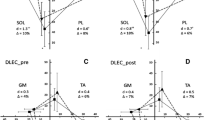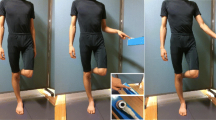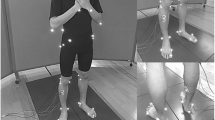Abstract
Purpose
Incomplete maturation and aging-induced declines of the neuromuscular system affect postural control both in children and older adults and lead to high fall rates. Age-specific comparisons of the modulation of ankle muscle activation and behavioral center of pressure (COP) indices during upright stance have been rarely conducted. The objective of the present study was to quantify aging effects on a neuromuscular level. Thus, surface electromyography (SEMG) modulation and co-activity of ankle muscles during single-leg standing was compared in healthy children, young adults and seniors.
Methods
Postural steadiness (velocity and mean sway frequency of COP), relative muscle activation (SEMG modulation) and co-activation of two ankle muscles (tibialis anterior, TA; soleus, SO) were examined during single-leg stance in 19 children [age, 9.7 (SD 0.5) years], 30 adults [23.3 (1.5) years] and 29 seniors [62.7 (6.1) years].
Results
Velocity of COP in medio-lateral and anterior–posterior directions, mean sway frequency in anterior–posterior direction, relative muscle activation (TA and SO) and co-activation revealed large age effects (P < 0.003, η p 2 > 0.14). Post-hoc comparisons indicated higher COP velocities, anterior–posterior frequencies, relative SO activation and co-activation in children and seniors when compared with adults. Relative TA activation was higher in children and adults compared with seniors (P < 0.001).
Conclusions
Increased postural sway in children and seniors seems to be counteracted with higher TA/SO co-activity and SO modulation. However, TA modulation is higher in children and adults, whereas seniors’ TA modulation capacity is diminished. An aging-induced decline of TA motor units might account for deteriorations of TA modulation in seniors.





Similar content being viewed by others
Abbreviations
- ANOVA:
-
Analysis of variance
- COP:
-
Center of pressure
- CV:
-
Coefficient of variation, degree of modulation of SEMG activation curve
- EMG:
-
Electromyography
- η p 2 :
-
Partial eta-squared
- J :
-
Moment of inertia
- MF:
-
Mean frequency of the indicated COP trajectories
- SD:
-
Standard deviation
- SEMG:
-
Surface electromyography
- SLS:
-
Single-leg stance
- SO:
-
Soleus muscle
- TA:
-
Tibialis anterior muscle
- V :
-
Velocity of the indicated COP trajectories
- ML:
-
COP trajectory in the medio-lateral direction
- AP:
-
COP trajectory in the anterior–posterior direction
References
Adkin AL, Frank JS, Carpenter MG, Peysar GW (2000) Postural control is scaled to level of postural threat. Gait Posture 12:87–93
Amiridis IG, Hatzitaki V, Arabatzi F (2003) Age-induced modifications of static postural control in humans. Neurosci Lett 350:137–140
Baudry S, Duchateau J (2012) Age-related influence of vision and proprioception on Ia presynaptic inhibition in soleus muscle during upright stance. J Physiol 590:5541–5554
Baudry S, Lecoeuvre G, Duchateau J (2012) Age-related changes in the behavior of the muscle-tendon unit of the gastrocnemius medialis during upright stance. J Appl Physiol (1985) 112:296–304
Benjuya N, Melzer I, Kaplanski J (2004) Aging-induced shifts from a reliance on sensory input to muscle cocontraction during balanced standing. J Gerontol A Biol Sci Med Sci 59:166–171
Billot M, Simoneau EM, Van Hoecke J, Martin A (2010) Age-related relative increases in electromyography activity and torque according to the maximal capacity during upright standing. Eur J Appl Physiol 109:669–680
Browne J, O’Hare N (2000) Development of a novel method for assessing balance: the quantitative posturography system. Physiol Meas 21:525–534
Chiari L, Rocchi L, Cappello A (2002) Stabilometric parameters are affected by anthropometry and foot placement. Clin Biomech (Bristol Avon) 17:666–677
Connelly DM, Rice CL, Roos MR, Vandervoort AA (1999) Motor unit firing rates and contractile properties in tibialis anterior of young and old men. J Appl Physiol 87:843–852
Coren S (1993) The lateral preference inventory for measurement of handedness, footedness, eyedness, and earedness: norms for young adults. Bull Psychonom Soc 31:1–3
Donath L, Roth R, Rueegge A, Groppa M, Zahner L, Faude O (2013) Effects of slackline training on balance, jump performance and muscle activity in young children. Int J Sports Med 34:1093–1098
Donath L, Kurz E, Roth R, Zahner L, Faude O (2015) Different ankle muscle coordination patterns and co-activation during quiet stance between young adults and seniors do not change after a bout of high intensity training. BMC Geriatr 15:19
Donath L, Kurz E, Roth R, Zahner L, Faude O (2016a) Leg and trunk muscle coordination and postural sway during increasingly difficult standing balance tasks in young and older adults. Maturitas 91:60–68
Donath L, Roth R, Zahner L, Faude O (2016b) Slackline training and neuromuscular performance in seniors: a randomized controlled trial. Scand J Med Sci Sports 26:275–283
Dos Anjos FV, Pinto TP, Gazzoni M, Vieira TM (2017) The spatial distribution of ankle muscles activity discriminates aged from young subjects during standing. Front Hum Neurosci 11:190
Earles D, Vardaxis V, Koceja D (2001) Regulation of motor output between young and elderly subjects. Clin Neurophysiol 112:1273–1279
Eikema DJA, Hatzitaki V, Tzovaras D, Papaxanthis C (2014) Application of intermittent galvanic vestibular stimulation reveals age-related constraints in the multisensory reweighting of posture. Neurosci Lett 561:112–117
Geurts ACH, Nienhuis B, Mulder TW (1993) Intrasubject variability of selected force-platform parameters in the quantification of postural control. Arch Phys Med Rehabil 74:1144–1150
Granacher U, Muehlbauer T, Gollhofer A, Kressig RW, Zahner L (2011) An intergenerational approach in the promotion of balance and strength for fall prevention—a mini-review. Gerontology 57:304–315
Grosset JF, Mora I, Lambertz D, Perot C (2008) Voluntary activation of the triceps surae in prepubertal children. J Electromyogr Kinesiol 18:455–465
Günther M, Grimmer S, Siebert T, Blickhan R (2009) All leg joints contribute to quiet human stance: a mechanical analysis. J Biomech 42:2739–2746
Hermens HJ et al (1999) SENIAM 8. European recommendations for surface ElectroMyoGraphy. Roessingh Research and Development b.v., Enschede
Hunt MA, McManus FJ, Hinman RS, Bennell KL (2010) Predictors of single-leg standing balance in individuals with medial knee osteoarthritis. Arthritis Care Res (Hoboken) 62:496–500
Hytönen M, Pyykkö I, Aalto H, Starck J (1993) Postural control and age. Acta Otolaryngol 113:119–122
Kiers H, van Dieen JH, Brumagne S, Vanhees L (2015) Postural sway and integration of proprioceptive signals in subjects with LBP. Hum Mov Sci 39:109–120
Kouzaki M, Shinohara M (2010) Steadiness in plantar flexor muscles and its relation to postural sway in young and elderly adults. Muscle Nerve 42:78–87
Lambertz D, Mora I, Grosset JF, Perot C (2003) Evaluation of musculotendinous stiffness in prepubertal children and adults, taking into account muscle activity. J Appl Physiol (1985) 95:64–72
Laufer Y, Barak Y, Chemel I (2006) Age-related differences in the effect of a perceived threat to stability on postural control. J Gerontol A Biol Sci Med Sci 61:500–504
Lee AJY, Lin WH (2007) The influence of gender and somatotype on single-leg upright standing postural stability in children. J Appl Biomech 23:173–179
Lee SSM, Piazza SJ (2008) Inversion-eversion moment arms of gastrocnemius and tibialis anterior measured in vivo. J Biomech 41:3366–3370
Lemos T, Imbiriba LA, Vargas CD, Vieira TM (2015) Modulation of tibialis anterior muscle activity changes with upright stance width. J Electromyogr Kinesiol 25:168–174
Lin SI, Woollacott MH (2002) Postural muscle responses following changing balance threats in young, stable older, and unstable older adults. J Mot Behav 34:37–44
Muehlbauer T, Mettler C, Roth R, Granacher U (2014) One-leg standing performance and muscle activity: are there limb differences? J Appl Biomech 30:407–414
Nagai K, Yamada M, Uemura K, Tanaka B, Mori S, Yamada Y, Aoyama T, Ichihashi N, Tsuboyama T (2012) Effects of fear of falling on muscular coactivation during walking. Aging Clin Exp Res 24:157–161
Nelson-Wong E et al (2012) Increased fall risk is associated with elevated co-contraction about the ankle during static balance challenges in older adults. Eur J Appl Physiol 112:1379–1389
Olivier I, Palluel E, Nougier V (2008) Effects of attentional focus on postural sway in children and adults. Exp Brain Res 185:341–345
Paillard T, Noe F (2015) Techniques and methods for testing the postural function in healthy and pathological subjects. Biomed Res Int 2015:891390
Peterson ML, Christou E, Rosengren KS (2006) Children achieve adult-like sensory integration during stance at 12-years-old. Gait Posture 23:455–463
Prieto TE, Myklebust JB, Hoffmann RG, Lovett EG, Myklebust BM (1996) Measures of postural steadiness: differences between healthy young and elderly adults. IEEE Trans Biomed Eng 43:956–966
Prior S, Mitchell T, Whiteley R, O’Sullivan P, Williams BK, Racinais S, Farooq A (2014) The influence of changes in trunk and pelvic posture during single leg standing on hip and thigh muscle activation in a pain free population. BMC Sports Sci Med Rehabil 6:13
Richardson JK, Ashton-Miller JA, Lee SG, Jacobs K (1996) Moderate peripheral neuropathy impairs weight transfer and unipedal balance in the elderly. Arch Phys Med Rehabil 77:1152–1156
Ross S, Guskiewicz K, Prentice W, Schneider R, Yu B (2004) Comparison of biomechanical factors between the kicking and stance limbs. J Sport Rehabil 13:135–150
Ruffieux J, Keller M, Lauber B, Taube W (2015) Changes in standing and walking performance under dual-task conditions across the lifespan. Sports Med 45:1739–1758
Seidler-Dobrin RD, He J, Stelmach GE (1998) Coactivation to reduce variability in the elderly. Mot Control 2:314–330
Simoneau E, Martin A, Van Hoecke J (2005) Muscular performances at the ankle joint in young and elderly men. J Gerontol A Biol Sci Med Sci 60:439–447
Springer BA, Marin R, Cyhan T, Roberts H, Gill NW (2007) Normative values for the unipedal stance test with eyes open and closed. J Geriatr Phys Ther 30:8–15
Steindl R, Kunz K, Schrott-Fischer A, Scholtz AW (2006) Effect of age and sex on maturation of sensory systems and balance control. Dev Med Child Neurol 48:477–482
Tabara Y et al (2015) Association of postural instability with asymptomatic cerebrovascular damage and cognitive decline: the Japan Shimanami health promoting program study. Stroke 46:16–22
Talis VL, Grishin AA, Solopova IA, Oskanyan TL, Belenky VE, Ivanenko YP (2008) Asymmetric leg loading during sit-to-stand, walking and quiet standing in patients after unilateral total hip replacement surgery. Clin Biomech (Bristol Avon) 23:424–433
Tracy BL, Enoka RM (2002) Older adults are less steady during submaximal isometric contractions with the knee extensor muscles. J Appl Physiol 92:1004–1012
Tracy BL, Howard RA (2004) Fluctuations in ankle dorsiflexor force are similar in young and old men and women. Med Sci Sports Exerc 36:S123
Vette AH, Sayenko DG, Jones M, Abe MO, Nakazawa K, Masani K (2017) Ankle muscle co-contractions during quiet standing are associated with decreased postural steadiness in the elderly. Gait Posture 55:31–36
Warnica MJ, Weaver TB, Prentice SD, Laing AC (2014) The influence of ankle muscle activation on postural sway during quiet stance. Gait Posture 39:1115–1121
Wolf SL, Kim JH (1997) Morphological analysis of the human tibialis anterior and medial gastrocnemius muscles. Acta Anat (Basel) 158:287–295
Zumbrunn T, MacWilliams BA, Johnson BA (2011) Evaluation of a single leg stance balance test in children. Gait Posture 34:174–177
Acknowledgements
We highly appreciate participants’ compliance and confidence. The authors would like to thank Ms. Tara Russell for language assistance.
Author information
Authors and Affiliations
Corresponding author
Ethics declarations
Conflict of interest
The authors declare that they have no conflict of interest.
Additional information
Communicated by Benedicte Schepens.
Rights and permissions
About this article
Cite this article
Kurz, E., Faude, O., Roth, R. et al. Ankle muscle activity modulation during single-leg stance differs between children, young adults and seniors. Eur J Appl Physiol 118, 239–247 (2018). https://doi.org/10.1007/s00421-017-3764-0
Received:
Accepted:
Published:
Issue Date:
DOI: https://doi.org/10.1007/s00421-017-3764-0




